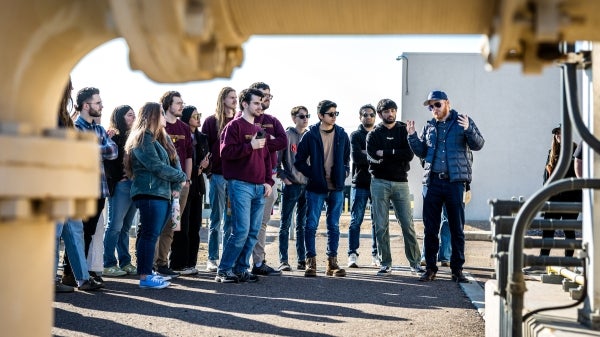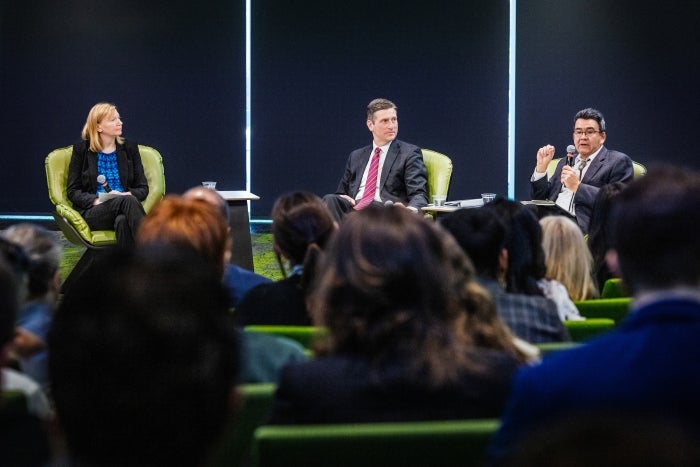Stanton urges bipartisan, national action on Colorado River water

U.S. Rep. Greg Stanton discussed the urgency of resuming negotiations over the Colorado River allotment at the inaugural ASU Congressional Dialogue on Tuesday at the Walton Center for Planetary Health on the Tempe campus. Photo by Charlie Leight/ASU News
Time is running out to determine the future of the depleted Colorado River, and any further delays in negotiating a deal could be catastrophic, according to U.S. Rep. Greg Stanton.
Learn more about water in Arizona
The Arizona Water Innovation Initiative is a statewide project led by the Julie Ann Wrigley Global Futures Laboratory in collaboration with Ira A. Fulton Schools of Engineering at ASU, working with industrial, municipal, agricultural, tribal and international partners on conservation, augmentation, desalination, efficiency, infrastructure and reuse.
Learn more here:
Stanton, who represents Arizona’s 4th District in Congress, participated in the inaugural ASU Congressional Dialogue on Tuesday at the Walton Center for Planetary Health on Arizona State University’s Tempe campus. The event, sponsored by the ASU Office of Government and Community Engagement, was titled “The Fight to Protect the Colorado River and Our Water Future.” There will be additional Congressional Dialogues later in the year.
The 1922 Colorado River Compact regulates water distribution among seven states — Arizona, Nevada and California in the Lower Basin, and Colorado, New Mexico, Utah and Wyoming in the Upper Basin.
Climate change has produced a megadrought that has reduced water in the Colorado River, which was already overallocated to the seven states. Decreases in water allotments over the past few years have cut Arizona’s share by about one-fifth.
The deal expires in 2026, and the U.S. Bureau of Reclamation must decide how to manage the river, including the rights of tribal nations and Mexico, which weren’t part of the original agreement.
The Lower and Upper basin regions are at odds over the future of the river, and Stanton blames the Biden administration for not pressuring the two sides to meet as the clock ticks on the expiration.
“The result is that the states are probably further apart than they have ever been on what the future of the river should look like,” he said.
“With Arizona, Nevada and California, we have put forth a serious proposal. The Upper Basin states say they shouldn't have to take any cuts because they have never used their full allocation of water.
“Rather than sit down and have serious negotiations, they are threatening litigation. It is an unacceptable situation. Now we're in the Trump administration, and we're in for a do-or-die moment for the future of the river.”
Although Arizona has made huge strides in conserving water, it’s not enough, Stanton said.
“It’s important for all parties to recognize that we cannot and will not save the Colorado River simply by cutting water use in the Lower Basin alone,” he said.
Stanton noted that Congress has approved funding for important infrastructure projects that could conserve water, and he called upon the Trump administration to act.
“Congress had the foresight to provide these funds because we knew immediate action was needed to protect the critical levels in Lake Mead,” he said.
Securing the water supply is significant not only for Arizona but for national security because of the surge in semiconductor manufacturing underway.
“Part of my job in Congress is to educate my fellow Congress members as to why the future of the Colorado River isn’t a Southwest thing or for the Western part of the United States, but critically important to the entire United States,” he said.
Stanton participated in a question-and-answer session with Mike Connor, who was the U.S. assistant secretary of the Army for civil works in the Biden administration and U.S. deputy secretary of the interior under President Barack Obama. Connor said that newly appointed Secretary of the Interior Doug Burgum needs to become involved in getting the sides together and that the federal government must be willing to invest in the Colorado River Basin.
“The reality is that we can’t go back to managing the system of certain (water) releases under certain conditions. We need new tools. We need to facilitate conservation,” he said.
“We need to manage these reservoirs in a way that accepts that conservation and continues to make the transition to the more arid environment and climate that exists in the basin.”
Stanton credited ASU for its work in researching the water crisis, and one of the university’s top experts, Dave White, director of the ASU Global Institute of Sustainability and Innovation, told the crowd about the Arizona Water Innovation Initiative.
The initiative focuses on five areas: technology to create tools for water augmentation, conservation treatment and reuse; data modeling to predict risks and vulnerabilities in hydrologic systems; research, analysis, collaboration and dialogue in the Kyl Center for Water Policy; community engagement in finding solutions; and partnering with water-insecure communities to improve access to reliable water.
“Our goal is to deliver actionable solutions and immediate impact that strengthen water resilience and economic competitiveness,” White said.
More Environment and sustainability

Single-use or reusable cups? New project seeks answers
Arizona State University researchers are collaborating with Yum! Brands on a joint research project to assess and better understand circular economy strategies that aim to replace single-use cups…

ASU Global Futures to lead Student Council Sustainability Officer Program
For over 11 years, through the Student Council Sustainability Officers Program, the city of Phoenix has engaged with students from their school districts to increase environmental stewardship.As…

From sludge to solutions: ASU students collaborate with city of Tempe on water treatment
Over the years, Arizona State University’s Project Cities has provided local communities and municipalities with expertise on sustainable solutions for parks, design research, solid waste, general…
